




















|
|
 The transit or passage of a planet across the face of the Sun is a relatively rare occurrence. As seen from Earth, only transits of Mercury and Venus are possible. On the average, there are 13 transits of Mercury each century. In comparison, transits of Venus occur in pairs with more than a century separating each pair.
On Wednesday, 2003 May 07, Mercury will transit the Sun for the first time since 1999. The entire event will be widely visible from the Europe, Africa and Asia as shown in the map in Figure 1. Japan Australia, and New Zealand will witness the beginning of the transit but the Sun will set before the event ends. Similarly, observers in western Africa, eastern North America and eastern South America will see the end of the event since the transit will already be in progress at sunrise from those regions.
The principal events occurring during a transit are conveniently characterized by contacts, analogous to the contacts of an annular solar eclipse. The transit begins with contact I which is the instant when the planet's disk is externally tangent with the Sun. Shortly after contact I, the planet can be seen as a small notch along the solar limb. The entire disk of the planet is first seen at contact II when the planet is internally tangent with the Sun. During the next several hours, the silhouetted planet slowly traverses the brilliant solar disk. At contact III, the planet reaches the opposite limb and once again is internally tangent with the Sun. Finally, the transit ends at contact IV when the planet's limb is externally tangent to the Sun. Contacts I and II define the phase called ingress while contacts III and IV are known as egress. Position angles for Mercury at each contact are measured counterclockwise from the north point on the Sun's disk.
All transits of Mercury fall within several days of 8 May and 10 November. Since Mercury's orbit is inclined seven degrees to Earth's, it intersects the ecliptic at two points or nodes which cross the Sun each year on those dates. If Mercury passes through inferior conjunction at that time, a transit will occur. During November transits, Mercury is near perihelion and exhibits a disk only 10 arc-seconds in diameter. By comparison, the planet is near aphelion during May transits and appears 12 arc-seconds across. However, the probability of a May transit is smaller by a factor of almost two. Mercury's slower orbital motion at aphelion makes it less likely to cross the node during the critical period. November transits recur at intervals of 7, 13, or 33 years while May transits recur only over the latter two intervals.
source: http://sunearth.gsfc.nasa.gov/eclipse/OH/transit03.html
Click on images for full-sized view.
The transit or passage of a planet across the face of the Sun is a relatively rare occurrence. As seen from Earth, only transits of Mercury and Venus are possible. On the average, there are 13 transits of Mercury each century. In comparison, transits of Venus occur in pairs with more than a century separating each pair.
On Wednesday, 2003 May 07, Mercury will transit the Sun for the first time since 1999. The entire event will be widely visible from the Europe, Africa and Asia as shown in the map in Figure 1. Japan Australia, and New Zealand will witness the beginning of the transit but the Sun will set before the event ends. Similarly, observers in western Africa, eastern North America and eastern South America will see the end of the event since the transit will already be in progress at sunrise from those regions.
The principal events occurring during a transit are conveniently characterized by contacts, analogous to the contacts of an annular solar eclipse. The transit begins with contact I which is the instant when the planet's disk is externally tangent with the Sun. Shortly after contact I, the planet can be seen as a small notch along the solar limb. The entire disk of the planet is first seen at contact II when the planet is internally tangent with the Sun. During the next several hours, the silhouetted planet slowly traverses the brilliant solar disk. At contact III, the planet reaches the opposite limb and once again is internally tangent with the Sun. Finally, the transit ends at contact IV when the planet's limb is externally tangent to the Sun. Contacts I and II define the phase called ingress while contacts III and IV are known as egress. Position angles for Mercury at each contact are measured counterclockwise from the north point on the Sun's disk.
All transits of Mercury fall within several days of 8 May and 10 November. Since Mercury's orbit is inclined seven degrees to Earth's, it intersects the ecliptic at two points or nodes which cross the Sun each year on those dates. If Mercury passes through inferior conjunction at that time, a transit will occur. During November transits, Mercury is near perihelion and exhibits a disk only 10 arc-seconds in diameter. By comparison, the planet is near aphelion during May transits and appears 12 arc-seconds across. However, the probability of a May transit is smaller by a factor of almost two. Mercury's slower orbital motion at aphelion makes it less likely to cross the node during the critical period. November transits recur at intervals of 7, 13, or 33 years while May transits recur only over the latter two intervals.
source: http://sunearth.gsfc.nasa.gov/eclipse/OH/transit03.html
Click on images for full-sized view.
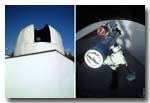 |
Transit of Mercury Photography. Equipment: Vixen 102 F/9.8; Takahashi FS60C; FujiFilm FinePix S1 Pro |
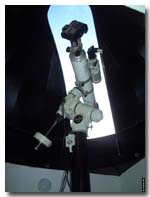 |
Transit of Mercury Photography. Equipment: Vixen 102 F/9.8; Takahashi FS60C; FujiFilm FinePix S1 Pro |
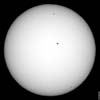 |
Vixen 102 F/9.8, FujiFilm FinePix S1 Pro (06:50UTC) |
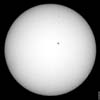 |
Vixen 102 F/9.8, FujiFilm FinePix S1 Pro (07:15UTC) |
 |
Vixen 102 F/9.8, FujiFilm FinePix S1 Pro (07:28UTC) |
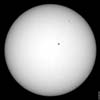 |
Vixen 102 F/9.8, FujiFilm FinePix S1 Pro (08:15UTC) |
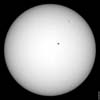 |
Vixen 102 F/9.8, FujiFilm FinePix S1 Pro (08:16UTC) |
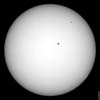 |
Vixen 102 F/9.8, FujiFilm FinePix S1 Pro (08:30UTC) |
Animated Gif (600kB)
|





















 The transit or passage of a planet across the face of the Sun is a relatively rare occurrence. As seen from Earth, only transits of Mercury and Venus are possible. On the average, there are 13 transits of Mercury each century. In comparison, transits of Venus occur in pairs with more than a century separating each pair.
On Wednesday, 2003 May 07, Mercury will transit the Sun for the first time since 1999. The entire event will be widely visible from the Europe, Africa and Asia as shown in the map in Figure 1. Japan Australia, and New Zealand will witness the beginning of the transit but the Sun will set before the event ends. Similarly, observers in western Africa, eastern North America and eastern South America will see the end of the event since the transit will already be in progress at sunrise from those regions.
The principal events occurring during a transit are conveniently characterized by contacts, analogous to the contacts of an annular solar eclipse. The transit begins with contact I which is the instant when the planet's disk is externally tangent with the Sun. Shortly after contact I, the planet can be seen as a small notch along the solar limb. The entire disk of the planet is first seen at contact II when the planet is internally tangent with the Sun. During the next several hours, the silhouetted planet slowly traverses the brilliant solar disk. At contact III, the planet reaches the opposite limb and once again is internally tangent with the Sun. Finally, the transit ends at contact IV when the planet's limb is externally tangent to the Sun. Contacts I and II define the phase called ingress while contacts III and IV are known as egress. Position angles for Mercury at each contact are measured counterclockwise from the north point on the Sun's disk.
All transits of Mercury fall within several days of 8 May and 10 November. Since Mercury's orbit is inclined seven degrees to Earth's, it intersects the ecliptic at two points or nodes which cross the Sun each year on those dates. If Mercury passes through inferior conjunction at that time, a transit will occur. During November transits, Mercury is near perihelion and exhibits a disk only 10 arc-seconds in diameter. By comparison, the planet is near aphelion during May transits and appears 12 arc-seconds across. However, the probability of a May transit is smaller by a factor of almost two. Mercury's slower orbital motion at aphelion makes it less likely to cross the node during the critical period. November transits recur at intervals of 7, 13, or 33 years while May transits recur only over the latter two intervals.
source: http://sunearth.gsfc.nasa.gov/eclipse/OH/transit03.html
Click on images for full-sized view.
Animated Gif (600kB)
The transit or passage of a planet across the face of the Sun is a relatively rare occurrence. As seen from Earth, only transits of Mercury and Venus are possible. On the average, there are 13 transits of Mercury each century. In comparison, transits of Venus occur in pairs with more than a century separating each pair.
On Wednesday, 2003 May 07, Mercury will transit the Sun for the first time since 1999. The entire event will be widely visible from the Europe, Africa and Asia as shown in the map in Figure 1. Japan Australia, and New Zealand will witness the beginning of the transit but the Sun will set before the event ends. Similarly, observers in western Africa, eastern North America and eastern South America will see the end of the event since the transit will already be in progress at sunrise from those regions.
The principal events occurring during a transit are conveniently characterized by contacts, analogous to the contacts of an annular solar eclipse. The transit begins with contact I which is the instant when the planet's disk is externally tangent with the Sun. Shortly after contact I, the planet can be seen as a small notch along the solar limb. The entire disk of the planet is first seen at contact II when the planet is internally tangent with the Sun. During the next several hours, the silhouetted planet slowly traverses the brilliant solar disk. At contact III, the planet reaches the opposite limb and once again is internally tangent with the Sun. Finally, the transit ends at contact IV when the planet's limb is externally tangent to the Sun. Contacts I and II define the phase called ingress while contacts III and IV are known as egress. Position angles for Mercury at each contact are measured counterclockwise from the north point on the Sun's disk.
All transits of Mercury fall within several days of 8 May and 10 November. Since Mercury's orbit is inclined seven degrees to Earth's, it intersects the ecliptic at two points or nodes which cross the Sun each year on those dates. If Mercury passes through inferior conjunction at that time, a transit will occur. During November transits, Mercury is near perihelion and exhibits a disk only 10 arc-seconds in diameter. By comparison, the planet is near aphelion during May transits and appears 12 arc-seconds across. However, the probability of a May transit is smaller by a factor of almost two. Mercury's slower orbital motion at aphelion makes it less likely to cross the node during the critical period. November transits recur at intervals of 7, 13, or 33 years while May transits recur only over the latter two intervals.
source: http://sunearth.gsfc.nasa.gov/eclipse/OH/transit03.html
Click on images for full-sized view.
Animated Gif (600kB)







